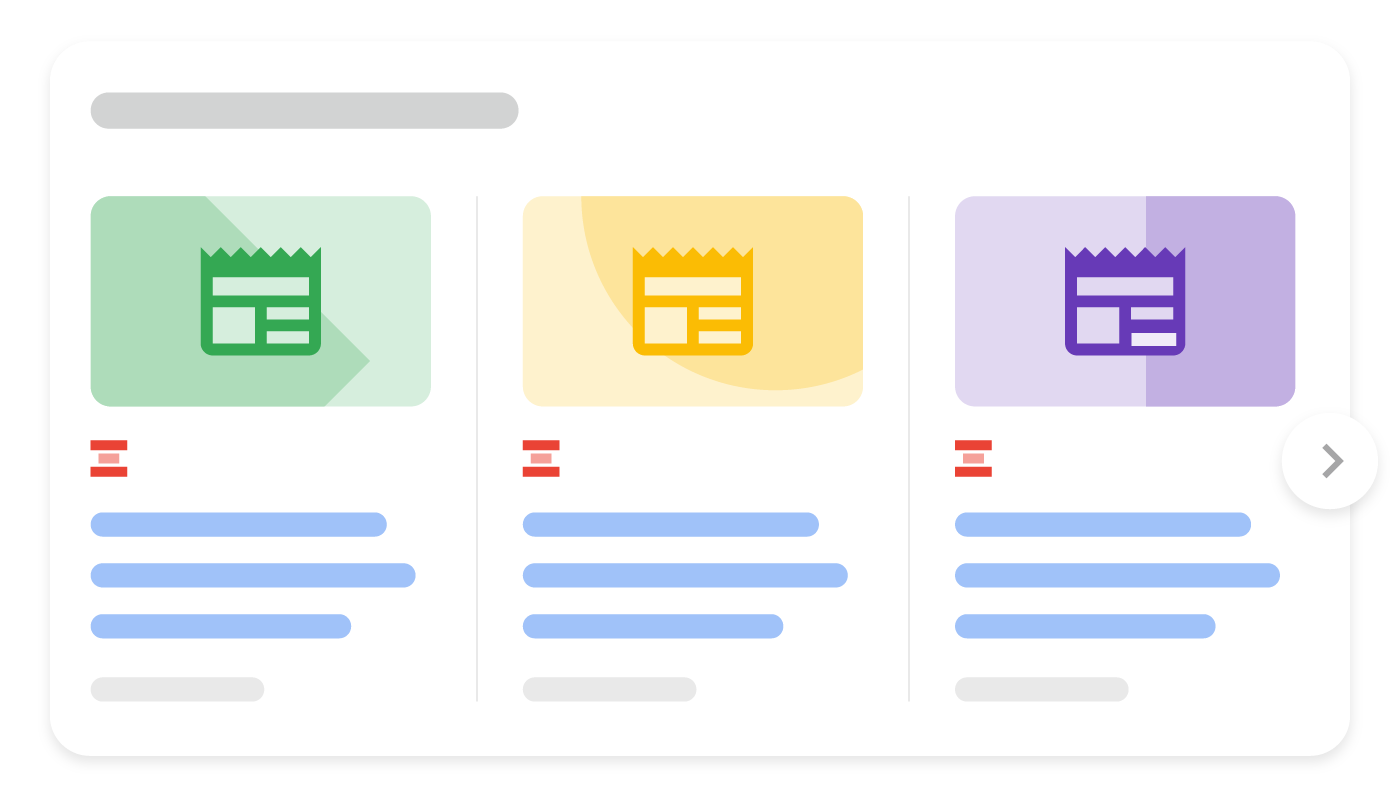文章 (Article、NewsArticle、BlogPosting) 結構化資料
在您的新聞、網誌與運動報導網頁中加入 Article 結構化資料,有助於 Google 進一步瞭解網頁內容,有效提升文章標題文字、圖片和日期資訊在 Google 搜尋的搜尋結果和其他資源 (例如 Google 新聞和 Google 助理) 中的顯示效果。雖然這些內容不必使用任何標記就能顯示在 Google 新聞功能 (例如焦點新聞) 中,但您可以加入 Article,明確向 Google 進一步指出內容的相關資訊 (舉例來說,指出這是新聞報導、作者是誰,或文章的標題是什麼)。

範例
以下是具有 Article 結構化資料的頁面範例。
JSON-LD
<html>
<head>
<title>Title of a News Article</title>
<script type="application/ld+json">
{
"@context": "https://schema.org",
"@type": "NewsArticle",
"headline": "Title of a News Article",
"image": [
"https://example.com/photos/1x1/photo.jpg",
"https://example.com/photos/4x3/photo.jpg",
"https://example.com/photos/16x9/photo.jpg"
],
"datePublished": "2024-01-05T08:00:00+08:00",
"dateModified": "2024-02-05T09:20:00+08:00",
"author": [{
"@type": "Person",
"name": "Jane Doe",
"url": "https://example.com/profile/janedoe123"
},{
"@type": "Person",
"name": "John Doe",
"url": "https://example.com/profile/johndoe123"
}]
}
</script>
</head>
<body>
</body>
</html>微資料
<html>
<head>
<title>Title of a News Article</title>
</head>
<body>
<div itemscope itemtype="https://schema.org/NewsArticle">
<div itemprop="headline">Title of News Article</div>
<meta itemprop="image" content="https://example.com/photos/1x1/photo.jpg" />
<meta itemprop="image" content="https://example.com/photos/4x3/photo.jpg" />
<img itemprop="image" src="https://example.com/photos/16x9/photo.jpg" />
<div>
<span itemprop="datePublished" content="2024-01-05T08:00:00+08:00">
January 5, 2024 at 8:00am
</span>
(last modified
<span itemprop="dateModified" content="2024-02-05T09:20:00+08:00">
February 5, 2024 at 9:20am
</span>
)
</div>
<div>
by
<span itemprop="author" itemscope itemtype="https://schema.org/Person">
<a itemprop="url" href="https://example.com/profile/janedoe123">
<span itemprop="name">Jane Doe</span>
</a>
</span>
and
<span itemprop="author" itemscope itemtype="https://schema.org/Person">
<a itemprop="url" href="https://example.com/profile/johndoe123">
<span itemprop="name">John Doe</span>
</a>
</span>
</div>
</div>
</body>
</html>如何新增結構化資料
結構化資料是一種標準化格式,能夠提供網頁相關資訊並分類網頁內容。如果您是第一次使用結構化資料,請參閱這篇文章,進一步瞭解結構化資料的運作方式。
以下簡要說明如何建立、測試及發布結構化資料。
- 盡可能加入網頁適用的建議屬性。提醒您,並沒有所謂的必要屬性,因此請改為加入適用於內容的屬性。根據您使用的格式,瞭解要在網頁中的什麼位置插入結構化資料。
- 遵循指南規範。
- 使用複合式搜尋結果測試驗證程式碼,並修正所有重大錯誤。此外,我們也建議您修正工具中可能標記的任何非重大問題,因為這有助於改善結構化資料的品質 (但並非符合複合式搜尋結果的顯示條件)。
- 部署幾個包含結構化資料的網頁,並使用網址檢查工具測試 Google 轉譯網頁的情形。請確認 Google 可以存取您的網頁,且網頁並未遭到 robots.txt 檔案或
noindex標記封鎖,也未設有登入規定。如果網頁看起來沒問題,您可以要求 Google 重新檢索您的網址。 - 為了讓 Google 掌握日後的異動內容,建議您提交 Sitemap。您可以使用 Search Console Sitemap API 自動執行這項操作。
指南規範
您必須按照下列規範啟用結構化資料,才能讓結構化資料顯示在 Google 搜尋結果中。
技術指南
- 如果有包含多篇文章的內容,請確保將
rel=canonical指向每個獨立網頁或是能夠「查看全部」的總覽網頁,而非分段系列中的第 1 頁。進一步瞭解標準化程序。 - 如果您的網站內容是以訂閱的方式開放瀏覽,或者使用者必須註冊才能瀏覽內容,建議您加入訂閱和付費牆內容的結構化資料。
結構化資料類型定義
為了讓 Google 更清楚瞭解您的網頁,請盡可能加入網頁適用的建議屬性。提醒您,並沒有所謂的必要屬性,因此請改為加入適用於內容的屬性。
Article 物件
Article 物件必須以下列其中一種 schema.org 類型為基礎:Article、NewsArticle、BlogPosting。
Google 支援的屬性如下:
| 建議屬性 | |
|---|---|
author |
文章的作者。為了讓 Google 更瞭解不同內容的作者,建議您遵循作者標記最佳做法。 |
author.name |
作者的名稱。 |
author.url |
可明確識別文章作者的網頁連結,例如作者的社群媒體頁面、「關於我」或簡介頁面。 如果網址是內部個人資料頁面,建議您使用個人資料頁面結構化資料標記該作者。 |
dateModified |
文章最近修改的日期和時間,採 ISO 8601 格式。 建議您提供時區資訊。否則,系統會預設為 Googlebot 使用的時區。 如果要向 Google 提供更精確的日期資訊,請加入 |
datePublished |
文章首次發布的日期和時間,採 ISO 8601 格式。建議您提供時區資訊。否則,系統會預設為 Googlebot 使用的時區。 如果要向 Google 提供更精確的日期資訊,請加入 |
headline |
文章的標題。建議您改用精簡的標題,因為部分裝置可能會截斷冗長的標題。 |
image |
重複的 可代表文章的圖片網址。請使用與文章相關的圖片,而非標誌或字幕。 其他圖片規範:
例如: "image": [ "https://example.com/photos/1x1/photo.jpg", "https://example.com/photos/4x3/photo.jpg", "https://example.com/photos/16x9/photo.jpg" ] |
作者標記最佳做法
為了讓 Google 更瞭解內容作者並以適當的方式呈現作者資訊,建議您在標記中指定作者時,採用下列最佳做法:
| 作者標記的最佳做法 | |
|---|---|
在標記中納入所有作者 |
確定在網頁上顯示為作者的所有作者都納入標記中。 |
指定多位作者 |
指定多位作者時,請為每位作者使用專屬的 "author": [
{"name": "Willow Lane"},
{"name": "Regula Felix"}
]
請勿將多位作者合併在同一 "author": {
"name": "Willow Lane, Regula Felix"
} |
使用其他欄位 |
為了讓 Google 更瞭解作者是誰,強烈建議您使用 舉例來說,如果作者是某人,您可以連結至作者網頁,提供作者詳細資訊: "author": [ { "@type": "Person", "name": "Willow Lane", "url": "https://www.example.com/staff/willow_lane" } ] 如果作者是某個機構,您就可以連結到該機構的首頁。 "author": [ { "@type":"Organization", "name": "Some News Agency", "url": "https://www.example.com/" } ] |
僅在 |
在
"author": [ { "@type": "Person", "name": "Echidna Jones", "honorificPrefix": "Dr", "jobTitle": "Editor in Chief" } ], "publisher": [ { "@type": "Organization", "name": "Bugs Daily" } ] } |
請使用適當的 |
對個人使用 |
以下為採用了作者標記最佳做法的範例:
"author": [ { "@type": "Person", "name": "Willow Lane", "jobTitle": "Journalist", "url": "https://www.example.com/staff/willow-lane" }, { "@type": "Person", "name": "Echidna Jones", "jobTitle": "Editor in Chief", "url": "https://www.example.com/staff/echidna-jones" } ], "publisher": { "@type": "Organization", "name": "The Daily Bug", "url": "https://www.example.com" }, // + Other fields related to the article... }
疑難排解
如果無法順利導入結構化資料,或是偵錯時遇到困難,請參考下列資源。
- 如果您使用內容管理系統 (CMS) 或者有他人代您處理網站事務,請向對方尋求協助。請務必將所有與問題相關的 Search Console 訊息都轉寄給對方,這些訊息會針對問題提供詳細說明。
- Google 不保證採用結構化資料的功能一定會顯示在搜尋結果中。如要瞭解為何 Google 無法將您的內容顯示為複合式搜尋結果,請參閱結構化資料通用指南裡的常見原因清單。
- 結構化資料可能含有錯誤。請查看結構化資料錯誤清單和無法剖析的結構化資料報告。
- 如果您的網頁遭到結構化資料人工判決處罰,系統會忽略網頁上的結構化資料,但該網頁仍然會出現在 Google 搜尋結果中。請使用人工判決處罰報告來修正結構化資料問題。
- 再次查看指南規範,確認您的內容是否符合規定。問題可能是因為垃圾內容或不當使用的標記所引起。不過,因為問題可能與語法無關,所以複合式搜尋結果測試無法找出問題所在。
- 參閱「疑難排解:未出現複合式搜尋結果/複合式搜尋結果總數減少」。
- 請等待一段時間,讓系統執行重新檢索和重新建立索引作業。在發布網頁後,Google 可能需要幾天時間才會找到網頁並進行檢索。如有關於檢索和索引建立作業的一般問題,請參閱 Google 搜尋檢索和索引常見問題。
- 前往 Google 搜尋中心論壇發文提問。
